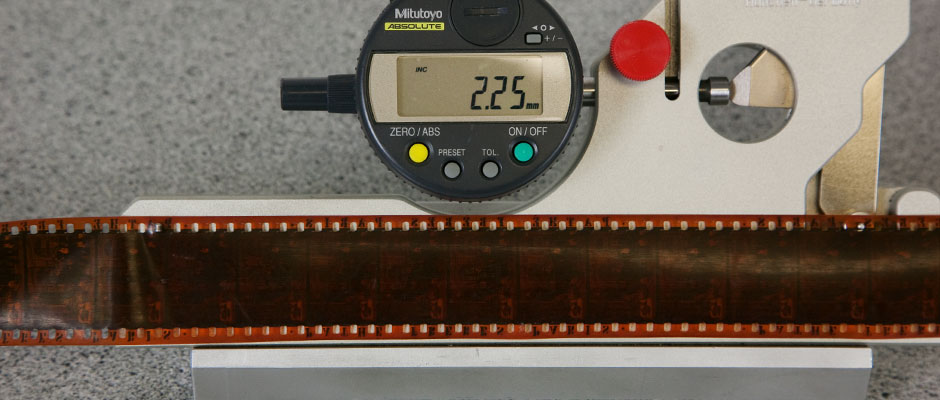


24 frames of unshrunken 16mm polyester countdown (on the left) are compared against 24 frames of shrunken 16mm acetate countdown. The acetate film has shrunk by about 4%. Shrinkage along the length of motion picture film causes misregistration of sprocket holes with projector teeth, and damage to prints can result when heavily shrunken film is projected. Acetate and nitrate bases are both prone to shrinkage, while polyester displays superior chemical and dimensional stability.

Here a tinted 35mm nitrate film is inspected for shrinkage. This reel also demonstrates spoking, a type of curl that can be caused by relative humidity of the storage environment and the dimensional changes caused by acetate and nitrate base decay.

This digital shrinkage gauge is used to measure the shrinkage of 35mm film. In this case, a tinted nitrate film from the early 20th century shows a shrinkage of over 2%.
What it is and what causes itShrinkage is the loss of the original dimensionality of the film. Acetate and nitrate bases are both susceptible to a small initial amount of shrinkage after their manufacture due to the loss of solvents. However, this initial shrinkage, well-known to film manufacturers, amounts to less than 0.1%. Dramatic shrinkage is caused by the natural chemical decay of nitrate and acetate film bases over time.Nitrate and acetate film bases are polymers of modified cellulose. Nitrate plastic is made by grafting nitro groups on to long chains of cellulose, and acetate plastics are made by grafting acetyl groups to cellulose chains. Over time, as these plastics are exposed to heat, moisture, and acids, these side groups (whether nitro or acetyl) detach and become free acids in the film’s storage environment. Once detached, the free acids promote chain scission, breaking apart the long polymer chains of cellulose. As the side groups split off, and the polymers shorten, the film base shrinks. In the case of motion picture film, shrinkage of over 1% can present a serious problem, as the sprocket-holes of shrunken film will no longer properly align with projector sprocket teeth, resulting in damage on projection, printing, or scanning of the film. In sheet film, 10% shrinkage is not atypical, and is often accompanied by delamination. |
What you can doShrinkage due to chemical decay is irreversible. Prevention of shrinkage requires storage in a cold or frozen and moderately dry environment, since such an environment will stall the progress of chemical decay. |
At Risk
|